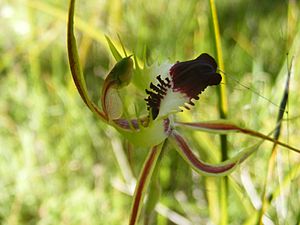Hairy spider orchid facts for kids
Quick facts for kids Hairy spider orchid |
|
|---|---|
 |
|
| Scientific classification | |
| Genus: |
Caladenia
|
| Species: |
villosissima
|
| Synonyms | |
|
|
The hairy spider orchid (scientific name: Caladenia villosissima) is a special type of orchid. It belongs to the orchid family, called Orchidaceae. This plant is found only in Victoria, which means it is endemic there.
It is a ground orchid, meaning it grows in the soil. It has one leaf that is very hairy. The plant produces a single pale green flower. This flower has cool red stripes on its sepals and petals. Scientists don't know a lot about this orchid yet. More information is needed to find out how many there are and where exactly they grow. This will help determine if it is an endangered species.
Contents
What the Hairy Spider Orchid Looks Like
The hairy spider orchid is a perennial plant. This means it lives for more than two years. It is also deciduous, so it sheds its leaves. It is a herb that grows from an underground tuber, which is like a small storage root.
Each plant has one leaf that is very hairy. This leaf is usually 60 to 140 millimeters long. It is also about 6 to 9 millimeters wide. Sometimes, the leaf has red spots near its base.
A single greenish flower grows on a thick, hairy stem. This stem can be 100 to 230 millimeters tall. The flower itself is about 35 to 45 millimeters wide.
Flower Parts
The sepals and petals of the flower have thick, yellowish tips. These tips are called glandular tips. The tips on the sepals are 9 to 12 millimeters long. The tips on the petals are shorter, about 3 to 4 millimeters long.
The top sepal, called the dorsal sepal, stands straight up. It is 30 to 45 millimeters long and about 3 millimeters wide. The two side sepals are 28 to 40 millimeters long. They are about 4 millimeters wide. These side sepals grow parallel to each other. They can be held flat or point slightly downwards.
The petals are 20 to 25 millimeters long and about 2 millimeters wide. They are arranged like the side sepals.
The labellum is the special lip-like part of the orchid. It is pale green and white with a red tip. The labellum is 12 to 15 millimeters long and 13 to 16 millimeters wide. Its sides have thin green teeth that can be up to 3 millimeters long. The tip of the labellum curves downwards. There are also four rows of dark red bumps, called calli. These calli are about 3 millimeters long and run along the middle of the labellum.
This orchid usually blooms in September and October.
How the Hairy Spider Orchid Got Its Name
This orchid was first officially described in 1991. A scientist named Geoffrey Carr gave it the name Caladenia dilatata var. villosissima. He found the first plant, called the type specimen, near Stawell. His description was published in a paper called Indigenous Flora and Fauna Association Miscellaneous Paper 1.
Later, in 2001, David Jones and other scientists changed its status. They decided it was a full species and named it Arachnorchis villosissima. Then, in 2004, Stephen Hopper and Andrew Brown revised the name again. They finally named it Caladenia villosissima.
The second part of its scientific name, villosissima, comes from Latin. It is the strongest form of the Latin word villosus, which means "hairy." So, villosissima means "hairiest," referring to its very hairy leaf.
Where the Hairy Spider Orchid Lives
The hairy spider orchid is only known to grow near Stawell in Victoria, Australia. It lives in forests where river red gum trees grow. You can find it growing among the grasses in these forests.
Protecting the Hairy Spider Orchid
The Caladenia villosissima does not yet have a special threat status. This is because scientists are still learning about it. They need to find out more about where it grows and how many plants exist. This information will help them decide if the hairy spider orchid needs special protection to keep it from becoming endangered.

